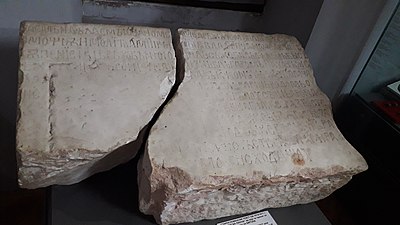
The Bitola inscription is a stone inscription from the First Bulgarian Empire written in the Old Church Slavonic language in the Cyrillic alphabet.[1] Currently, it is located at the Institute and Museum of Bitola, North Macedonia, among the permanent exhibitions as a significant epigraphic monument, described as "a marble slab with Cyrillic letters of Ivan Vladislav from 1015/17".[2] In the final stages of the Byzantine conquest of Bulgaria Ivan Vladislav was able to renovate and strengthen his last fortification, commemorating his work with this elaborate inscription.[3] The inscription found in 1956 in SR Macedonia, provided strong arguments supporting the Bulgarian character of Samuil's state, disputed by the Yugoslav scholars.[4]
- ^ Vasilka Tăpkova-Zaimova, Bulgarians by Birth: The Comitopuls, Emperor Samuel and their Successors According to Historical Sources and the Historiographic Tradition, East Central and Eastern Europe in the Middle Ages, 450–1450, BRILL, 2018, ISBN 9004352996, pp. 17–18.
- ^ "Among the most significant findings of this period presented in the permanent exhibition is the epigraphic monument a marble slab with Cyrillic letters of Jovan Vladislav from 1015/17." The official site of the Institute for preservation of monuments of culture, Museum and Gallery Bitola
- ^ Jonathan Shepard, Equilibrium to Expansion (886–1025); pp 493-536; from Part II - The Middle Empire c. 700–1204 in The Cambridge History of the Byzantine Empire C.500-1492 (2008) Cambridge University Press, p. 529, ISBN 0521832314.
- ^ The Bitola inscription (found in 1956) of the last Bulgarian king Ivan Vladislav, son of Aaron (and nephew of Samuil), in which he defined himself as Bulgarian by descent gave strong arguments in favor of the Bulgarian cause. Roumen Daskalov (2021) Master Narratives of the Middle Ages in Bulgaria, East Central and Eastern Europe in the Middle Ages, 450-1450, BRILL, pp. 226-227, ISBN 9004464875.